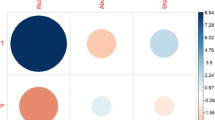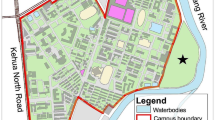Abstract
In order to identify the selection mechanism of two sympatric African browsers, we analysed encounter rates and selection of bushes along foraging pathways. We monitored the tracks, left overnight, by kudu and impala on an experimental plot of natural Acacia nilotica and Dichrostachys cinerea in the highveld of Zimbabwe, and recorded the number of bushes attacked in each category. Both ungulates were selective for the bush categories, but kudu were consistently more selective than impala, and showed a higher preference for the larger A. nilotica and D. cinerea bushes, which had a significantly greater number of bites which were not reachable by impala. For both kudu and impala, the probability of attacking larger bushes increased significantly with the proportion of large bushes encountered along the foraging pathways, whereas the consumption of smaller bushes was apparently unpredictable. For the most abundant food item (medium D. cinerea), the probability of attack by impala along a pathway decreased with increasing proportions of larger bushes in the experimental area, but was also dependent on impala group size and season. In addition, we found that encounter rates with larger bushes were significantly higher for kudu than for impala. Experimentally reducing the availability of the larger bushes had little effect on both impala and kudu during the following rainy season. However, during the following cool dry season, kudu showed an increased selectivity with a strong preference for the remaining large bushes (large A. nilotica), followed by a sharp decrease in selectivity in the hot dry season when they also fed from significant numbers of medium trees. Impala had little reaction to the experimental changes in the availability of bush categories in either season. We suggest that both kudu and impala selected bushes on the basis of the potential number of bites they can provide, and this resulted in different search strategies. Kudu focussed on the larger bushes which have a larger number of twigs which are out of reach of impala and kudu also probably directed their path preferentially towards the few larger bushes to maximize encounter rates with this favoured bush category. These differences in bush selection process lead to a low overlap in resource use between the two browsers in this type of savanna.




Similar content being viewed by others
References
Aström M, Lundberg P, Danell K (1990) Partial prey consumption by browsers: trees as patches. J Anim Ecol 59:287–300
Belovsky GE (1984) Moose and snowshow hare competition and a mechanistic explanation for foraging theory. Oecologia 64:150–159
Cahill JF, Castelli J, Casper B (2001) The herbivory uncertainty principle: visiting plants can alter herbivory. Ecology 82:307–312
Cooper SM, Owen-Smith N (1986) Effects of plant spinescence on large mammalian herbivores. Oecologia 68:446–455
du Toit JT (1990) Feeding-height stratification among African browsing ruminants. Afr J Ecol 28:55–61
Duncan P (1983) Determinants of the use of habitat by horses in a Mediterranean wetland. J Anim Ecol 52:93–109
Dunham KM (1982) The foraging behaviour of impala Aepyceros melampus. S Afr J Wildl Res 12:36–40
Etzenhouser M, Owens MK, Spalinger DE, Murden SB (1998) Foraging behavior of browsing ruminants in a heterogeneous landscape. Landscape Ecol 13:55–64
Fritz H, de Garine-Wichatitsky M (1996) Foraging in a social antelope: effects of group size on foraging choices and resource perception in impala. J Anim Ecol 65:736–742
Fritz H, de Garine-Wichatitsky M, Letessier G, Ducornez S, Chiparo E (1995) The importance of browse for cattle. In: Hofmann RR, Schwartz HJ (eds) Proceedings of the international symposium on wild and domestic ruminants in extensive land use systems. Humboldt University, Berlin, pp 177–184
Fritz H, de Garine-Wichatitsky M, Letessier G (1996) Habitat use by sympatric wild and domestic herbivores in an African savanna woodland: the influence of cattle spatial behaviour. J Appl Ecol 33:589–598
Gordon IJ, Illius AW (1988) Incisor arcade structure and diet selection in ruminants. Funct Ecol 2:15–22
Gordon IJ, Illius AW (1989) Resource partitioning by the ungulates on the Isle of Rhum. Oecologia 79:383–389
Gordon IJ, Illius AW (1996) The nutritional ecology of African ruminants: a reinterpretation. J Anim Ecol 65:18–28
Hofmann RR (1989) Evolutionary steps of ecophysiological adaptations and diversification of ruminants: a comparative view of their digestive systems. Oecologia 78:443–457
Hofmann RR, Stewart DRM (1972) Grazer or browser: a classification based on the stomach structure of and feeding habits of Eastern African ruminants. Mammalia 36:226–240
Hosmer DW, Lemeshow S (1989) Applied logistic regression. Wiley, New York
Hunter RF (1962) Hill sheep and their pasture: a study of sheep grazing in South East Scotland. J Ecol 50:651–680
Illius AW, Fitzgibbon C (1994) Costs of vigilance in foraging ungulates. Anim Behav 47:481–484
Illius AW, Gordon IJ (1987) The allometry of food intake in grazing ruminants. J Anim Ecol 56:989–999
Illius AW, Gordon IJ (1992) Modelling the nutritional ecology of ungulate herbivores: evolution of body size and competitive interactions. Oecologia 89:428–434
Jarman PJ (1972) Seasonal distribution of the large mammals populations in the unflooded middle Zambezi valley. J Appl Ecol 9:283–2299
Lamprey HF (1963) Ecological separation of the large species in the Tarangire Game Reserve, Tanganyika. East Afr Wildl J 1:63–92
Leuthold W (1978) Ecological separation among browsing ungulates in Tsavo East National Park, Kenya. Oecologia 35:241–252
McNaughton SJ, Georgiadis NJ (1986) Ecology of African grazing and browsing mammals. Annu Rev Ecol Syst 17:39–65
Owen-Smith N, Cooper SM (1987a) Assessing food preferences of ungulates by acceptability indices. J Wildl Manage 51:372–378
Owen-Smith N, Cooper SM (1987b) Palatability of woody plants to browsing ruminants in a South African savanna. Ecology 68:319–331
Owen-Smith N, Novellie P (1982) What should a clever ungulate eat? Am Nat 119:151–178
Perry G, Pianka ER (1997) Animal foraging: past present and future. Trends Ecol Evol 12:360–364
Pianka ER (1973) The structure of lizard communities. Annu Rev Ecol Syst 4:53–74
Quinn GP, Keough MJ (2002) Experimental design and data analysis for biologists. Cambridge University Press, Cambridge
Skinner JD, Smithers RHN (1990) The mammals of the Southern African subregion, 2nd edn. University of Pretoria, Pretoria
Sokal RR, Rohlf FJ (1998) Biometry: the principles and practice of statistics in biological research, 3rd edn. Freeman, New York
SPSS (1999) SPSS version 9.0. SPSS, Chicago, Ill.
Stephens DW, Krebs JR (1986) Foraging theory. Princeton University Press, Princeton, N.J.
Wiens JA, Crist TO, With KA, Milne BT (1995) Fractal patterns of insect movement in microlandscape mosaics. Ecology 76:663–666
Woolnough AP, du Toit JT (2001) Vertical zonation of browse quality in tree canopies exposed to a size-structured guild of African browsing ungulates. Oecologia 129:585–590
Acknowledgements
We are grateful to ARDA for permission to carry out this study on Kelvin Grove Ranch and for field assistance. We would also like to deeply thank Billy Butete, Nelson Kombani, Nathalie Vittrant and Sophie Ducornez for their precious help in data collection. This work was funded by CIRAD and the French Ministry of Research and Education (M. G. W. was supported by a fellowship). I. J. G. and A. W. I. acknowledge the financial support of the UK Government’s Department for International Development under the Livestock Production Programme.
Author information
Authors and Affiliations
Corresponding author
Rights and permissions
About this article
Cite this article
de Garine-Wichatitsky, M., Fritz, H., Gordon, I.J. et al. Bush selection along foraging pathways by sympatric impala and greater kudu. Oecologia 141, 66–75 (2004). https://doi.org/10.1007/s00442-004-1630-3
Received:
Accepted:
Published:
Issue Date:
DOI: https://doi.org/10.1007/s00442-004-1630-3




